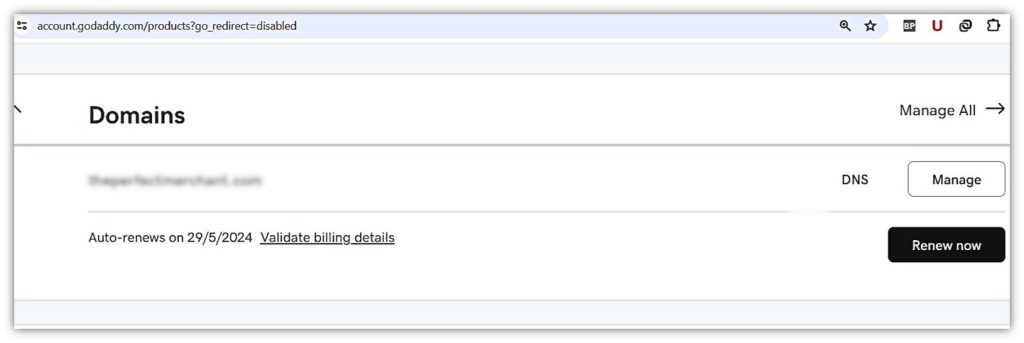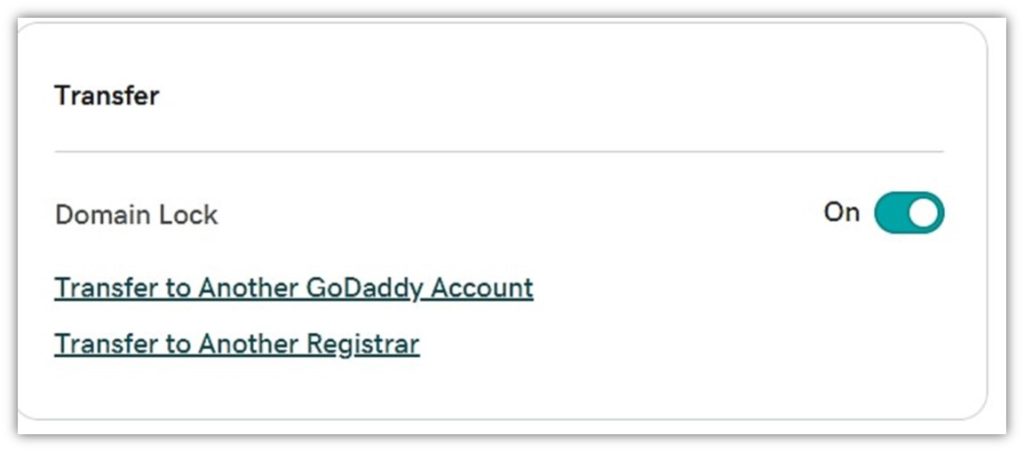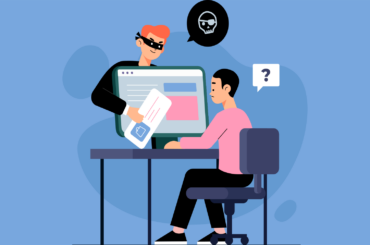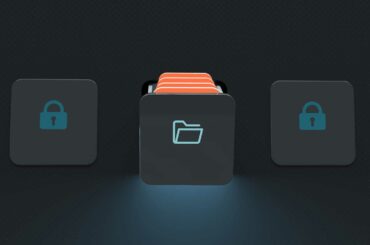In 2023, Frax Finance’s domain was compromised, and the company only regained control after intensive troubleshooting by its domain registrar. Here are 11 ways to avoid your company being the victim of domain hijacking.
As your business grows and becomes more successful, your domain becomes a bigger target for domain theft attacks. Domain hijacking typically exploits security weaknesses within a domain’s management process (weak account security, misconfigurations, etc.) to take control of your domain.
Online, your domain is not just a part of your business — it’s a key asset. If you don’t protect it, you’ll leave your front door open for thieves to exploit your organization’s good name and reputation to scam customers. Hijackers can disrupt your operations and compromise your data if they take over, or they can sell your stolen domain out from under you.
When it comes to domain theft or domain hijacking, your best bet is to safeguard against cybercriminals’ common attack tactics. Let’s explore how…
How Domain Theft & Hijacking Can Occur
Before we dive into the specific ways to prevent attacks, let’s quickly explore how bad guys carry them out. Three common domain hijacking methods are as follows:
- Phishing Attacks: Tactics to deceive individuals into divulging sensitive data, such as login credentials that give attackers full access to your domain.
- DNS Hijacking: Maliciously redirecting users from the intended site to a fraudulent one to intercept or manipulate data.
- Registrar Hijacking: Illegally transferring domain ownership, typically by exploiting security gaps or using stolen credentials.
To prevent your domain name from being stolen, you need to take steps to harden your human and technological defenses against these avenues of attack.
11 Ways to Prevent Domain Theft & Hijacking in Cyber Security
Here are 11 steps you can take to protect your domain from being hijacked by cybercriminals:
1. Partner with a Trusted Registrar
Kicking off your domain’s defense hardening by using a reputable registrar reduces a host of potential security issues right from the start. Otherwise, choosing an insecure or lesser-known domain registrar can leave your domain exposed to DNS spoofing attacks, where cybercriminals redirect your legitimate domain to fake look-alike sites.
Without dependable protection, domain owners may face increased risks such as:
- Significant disruptions to business operations.
- Unauthorized domain transfers.
- Permanent loss of the domain name.
- Indefinite downtime.
- Loss of control over their DNS settings.
- Loss of consumer trust and relationships.
- Revenue losses stemming from lost sales and business opportunities.
Collaborate With Reputable Entities to Prevent Domain Poaching
To mitigate the above risks, it’s essential to partner with a trusted registrar that prioritizes security and user support. Look for a registrar that:
- Is known for its strong security and reliable support.
- Is accredited by ICANN for verifiable credibility.
- Provides handy features like auto-renewals (more on this later) and easy-to-use management interfaces.
- Checks for a broad selection of TLDs to protect against domain squatting and brand impersonation.
- Gives you the option to keep your personal information private with WHOIS privacy (we’ll discuss this in the next point).
2. Maintain WHOIS Anonymity
Leaving your WHOIS details in the open can set you up for social engineering tactics. In these situations, attackers mine personal data they can use to manipulate you into giving up information or doing something that will lead to the compromise of your domain.
Cybercriminals continually advance their social engineering tactics to trick domain owners into divulging sensitive login credentials. This is why it is essential to keep your WHOIS information current and private. By doing so, you can protect yourself from a variety of risks, such as:
- Identity theft.
- Personal data breaches.
- And unauthorized domain access.
Keep Your Registration Details Undisclosed to Deter Unwelcomed Scrutiny
Here are practical steps to keep your domain registration details current and secure:
- Regularly update your WHOIS info to stay legally compliant and ready for any domain transfers or certificate setups.
- Use privacy protection to keep your personal details private and out of public records.
- Be aware that you might have to switch off privacy settings temporarily for certain domain updates.

3. Automate Your Domain Renewal
Letting your domain expire by accident can open the floodgates to opportunistic competitors who might snatch it up the moment it becomes available. But that’s not the worst part: an expired domain can quickly turn into a launch point for drive-by download attacks and other issues.
If a bad guy buys your expired domain before you have a chance to get it back, they can employ your trusted site as a phishing tool or use it to push malware onto unsuspecting visitors. This slip could erase the years you’ve spent building your brand and trust online and severely harm your brand’s reputation.
Enable Auto-Renew to Prevent Accidental Lapses and Opportunistic Takeovers
Keep your domain secure against domain theft and continuously registered by following these steps:
- Mark your calendar with your domain’s expiration date to prevent any slip-ups.
- Turn on auto-renewal to keep your domain registration seamless and secure.
- Consider setting up alerts as a backup to remind you when renewal time is near.

4. Set Registrar Lock Configurations to Reduce Risks of Unauthorized Domain Modifications
In an online environment where domain settings can be altered by unauthorized users, your domain’s integrity is constantly at risk. So, in addition to setting privacy levels and automating renewals, it’s wise to further strengthen your domain’s security by enabling specific registrar locks via statuses that block unauthorized changes on the client end.
Implement Key Domain Statuses to Prevent Unintended or Malicious Changes
Set these protective measures to keep your domain securely under your control:
- clientDeleteProhibited: Stops your domain from being deleted without your permission.
- clientRenewProhibited: Prevents anyone but you from renewing your domain.
- clientTransferProhibited: Keeps your domain from being transferred to another registrar unless you say so.
- clientUpdateProhibited: Ensures that changes to your domain’s registration details are made only with your approval.
Implementing these statuses effectively locks your domain against potential hijacking and unauthorized alterations, safeguarding your online identity.

5. Be Vigilant of Administrative Domain Changes
Unexpected adjustments in DNS configurations, administrative contacts, or domain lock status could indicate that someone has unauthorized access to your domain or there’s another potential security breach that requires immediate attention.
To stay on top of potential threats, it’s important not to ignore notifications or updates related to your domain settings. Ignoring these updates can lead to missed signs of unauthorized attempts to alter your domain details.
Monitor Updates Rigorously to Outpace Potential Intruders
Keep vigilant over your domain to catch any unusual activity early:
- Sign up for domain monitoring to get a heads-up on any changes, like updated nameserver info or transfer efforts.
- Enable multi-factor authentication, if available, on your domain’s account (which we’ll speak more about later)
- Act quickly on alerts to tackle any unauthorized changes and safeguard your domain.
6. Prioritize Strong Passwords
Using common or easy-to-guess passwords might invite brute force attacks in which your domain’s account login security is hammered until it cracks. Consequently, these insecure passwords can be exploited by miscreants to gain unauthorized access to your domain management tools.
Create Robust and Memorable Credentials to Thwart Brute Force Attacks
Strengthen your defense against unauthorized access by developing passwords that blend security with ease of recall:
- Aim for passwords (or, ideally passphrases) that mix numbers, letters (both upper and lower case), and symbols. The ideal length is at least 12 characters, making them complex yet manageable without constant reliance on a password manager.
- Avoid common or simplistic passwords that are easily guessed, such as sequential numbers or names.
- Choose passphrases composed of unrelated words combined with numbers and symbols, like “Sunset&Basketball89!Piano” because it’s easier to remember but is still difficult for attackers to crack.
- Consider using a mnemonic device or a phrase from a favorite song or book as a base for your passphrase, adding complexity with numbers and symbols to meet security standards.
| Strong Password Factors | Weak Example | Strong Example | Tips for Strength |
| Length | pass | Sunset89!Piano | Longer is better, aim for 12+ characters. |
| Upper and Lowercase | password | UNRELATEDstapleWORDS89! | Mix capital and small letters. |
| Numbers | password99 | Basket&Ball2023! | Embed numbers meaningfully. |
| Symbols | pass123 | Thrive_On@Life20! | Include symbols to add complexity. |
| Avoid Patterns | 123456 | Random$Word42* | Use random characters and unrelated words. |
| No Personal Info | john1980 | Unique*Phrase2024! | Avoid using easily guessable personal information. |
| Complexity | qwerty | D1V3RSE#Elements2024! | More complexity increases security. |
| Unpredictability | 111111 | Unpredictable_78!@Genius | Ensure the passphrase is unpredictable and unique. |
This table compares weak and strong password examples, illustrating how length, variety of characters, and unpredictability contribute to secure credentials.
7. Enable Multi-Factor Authentication
While using strong passwords is a great practice, these secrets can still fall short if you are hit with a credential-stuffing attack. This is a situation where your stolen or leaked credentials are used against you and give an unauthorized user access to your account.
Data breaches and leaks happen all of the time. Since relying on just a password alone often is not enough to fend off determined attackers, a multi-factor authentication (MFA) adds a critical second layer of security.
Layer Your Defenses With Additional Verification Steps
Double down on your login security by adding multiple layers of verification to confirm your identity:
- Initiate MFA protection: Add an essential layer of security by requiring more than just your password for access.
- Activate MFA on your domain registrar account: Enable MFA to reduce the risk of unauthorized access to your account. This provides an additional barrier even if your password later becomes compromised.
- Configure MFA requirements: Set up MFA to require a combination of:
- Something you know (your password).
- Something you have (a code sent to your phone or a security token).
- Something you are (biometric data like a fingerprint).
8. Address Security Risks with Encrypted Communications
Domains that use insecure connections are vulnerable to data breaches and credential theft, making them prime targets for man-in-the-middle attacks. When someone intercepts your sensitive login credentials in transit, they can use them to breach your account and take control of your domain.
Using an SSL/TLS certificate can help shore up those loose ends using public key encryption to protect your secrets in transit. This prevents attackers from being able to intercept, read, or modify the data without being detected.
You can also use SSL/TLS certificates to protect your data during file uploads and transfers to your database server. Using FTPS (FTP over TLS) instead of the insecure standard file transfer protocol ensures the data sent to and from your server is encrypted. An FTPS is required when updating website content or uploading sensitive data.
9. Ensure You’ve Enabled Domain Registry Locking
An unguarded domain is an easy pick for domain hijacking, enabling bad guys to whisk away your domain right under your nose. That’s exactly why it’s essential to keep your domain registry locked. This is an additional step that goes above and beyond the registrar locks we mentioned earlier.
So, what exactly is domain locking? Well, it’s fundamentally a security measure that prevents any changes to your domain’s registry settings without proper verification. This includes blocking unauthorized transfers of ownership and ensuring that hackers cannot modify ownership details without your express consent.
Activate Security Measures to Keep Your Domain Firmly Under Your Control
Secure your domain to prevent external manipulations:
- Add another layer of security via your registrar’s management dashboard to block unauthorized transfers and updates, typically at no extra cost.
- Consider a registry lock for another level of verification, acting as a triple-check before any major changes are made.

- If you don’t have an option like that showing, then manually use registry lock commands like ServerDeleteProhibited, ServerTransferProhibited, and ServerUpdateProhibited in combination with the client commands we mentioned in domain theft prevent method #4.
10. Keep an Eye Out for Phishing Attack Tactics
Phishing attacks, cleverly disguised as legitimate requests via email, phone, or SMS text messages, can trick you into giving away sensitive information, such as your login credentials. (We’ll discuss more about email security in a moment.)
Falling for such scams can compromise the security of your domain and lead to domain theft. For instance:
- A crafty email designed to look like it was sent by your domain registrar can lay the groundwork for bad guys to phish you out of your credentials.
- Bad guys could send a phishing link that has cross-site scripting (XSS) vulnerabilities included as part of the URL parameters. When an unsuspecting user clicks on it, that malicious script could be executed in their browser.
Learn to Recognize and Evade Deceptive Traps in Communications
Be astute and cautious to fend off phishing attempts:
- Recognize phishing threats: Attackers often send emails pretending to be from your registrar with links to fake sites.
- Avoid suspicious links: Never click on unverified links. Directly type your registrar’s URL into your browser instead.
- Check for authenticity: Verify the sender’s email address and look out for odd greetings or misspelled words.
- Use additional security features: Consider options like domain expiration protection and registration auto renewals to safeguard your domain.
The following video demonstrates how easy it is to launch phishing attacks, highlighting the need for cybersecurity awareness and protection strategies.
11. Fortify Your Registered Email Account’s Security
If not adequately protected, the email address you list with your domain registrar can be a gateway for potential security breaches. An insecure email account may open the door to various cyber threats, turning the interactions managed through your email into potential vulnerabilities.
Having this insecure email account could allow attackers to leverage compromised email credentials to gain administrative access to your domain and manipulate domain settings. As you can imagine, this can quickly escalate to domain theft or domain hijacking.
Strengthen Your Email Defenses as the Gateway to Your Domain’s Integrity
Keep the communication channel to your domain secure:
- Choose a reliable email provider that offers additional security features: Use email services that support robust multi-factor authentication (MFA).
- Maintain active and secure access: Ensure the email linked to your domain is active and regularly updated.
- Strengthen your password practices: Avoid recycling passwords (i.e., use a unique password for every account), update passwords regularly, and keep them confidential. Never share or reuse passwords.
Final Thoughts on Domain Theft Protection
As we conclude our article, we must reiterate that constant alertness is the key to maintaining the security of your domain and preventing domain theft. Being aware of common phishing “red flags” is a great start to help keep your domain-related account secrets secure.
Beyond selecting a secure registrar and crafting unbreakable passwords, a culture of continuous scrutiny is vital to your domain’s security. It’s a blend of proactive tactics (e.g., enabling HTTPS on your site for secure connections) and responsive strategies (e.g., using registry lock services to secure domain records) that, together, weave a stronger safety net for your domain.
Follow our SavvySecurity blogs for more updates on cybersecurity. Check out our security products and contact us to protect your domain and software services.





